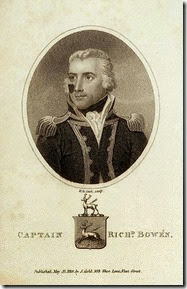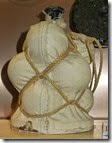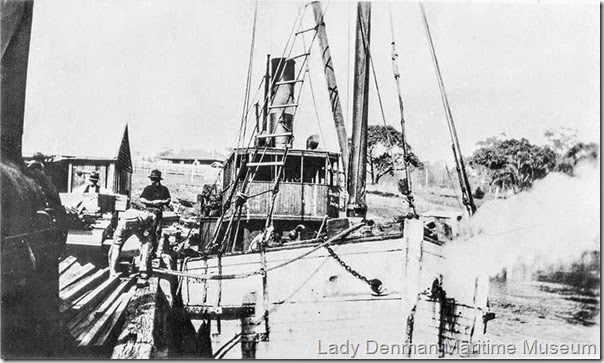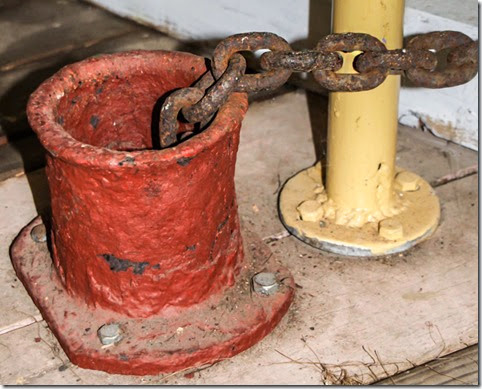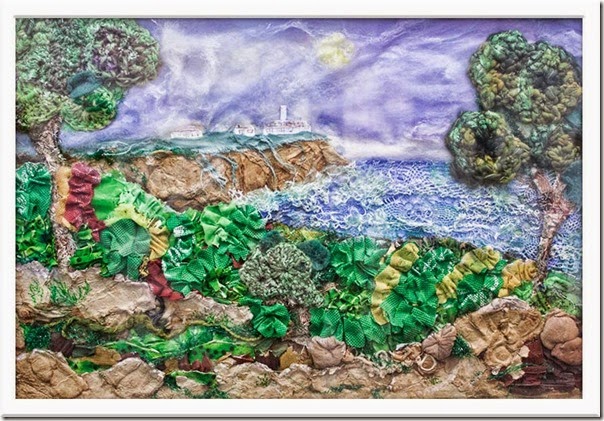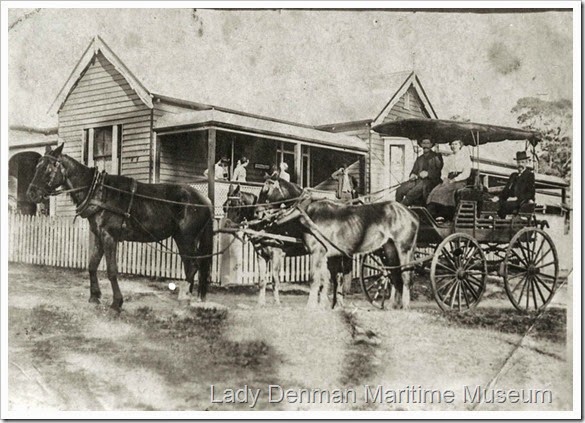A fascinating story about the good ship Port Hole and the ongoing restoration of the Crest as well as information about the Antiques Fair and it’s special guest.
CLICK FOR NEWSLETTER HERE.
29 July 2014
Museum July Newsletter on site now.
Loss of the Brigantine Schooner the George Thornton 1887

Built by Thomas Macaulay on the banks of Currumbene Creek Huskisson in 1880 for James H. Young & H.A. Gray of Sydney. She was a timber Schooner Brigantine Rigged measuring 105ft long, weighing and 185 tons.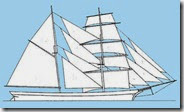
Brigantine Rigged Schooner.
Saturday 10 am.
Leaving Bundaberg with a fresh coat of paint and looking very smart, loaded with 70.00ft of hardwood, 90.000ft of pine and 40 tons of sugar making her way to Normanton she sprang a leak.
Sunday 10am.
On Sunday morning the mate sounded the hold and found only 3 inches of water, the result of ordinary sweating. The leak was not discovered until 10am, by then there was 4ft of water in the hold. Attempts were made to clear the vessel with pumps but were unavailing.
Sunday 1pm.
She was nearly full of water,seeing that all was useless, the decision to abandon ship was made and they lowered a boat with the intention to make for shore. At this time they saw the Lucinda’s smoke and returned to the vessel.
Waterlogged and Abandoned.
Fortunately the coastal steamer Lucinda came across the doomed vessel after sighting the George Thornton flying her ensign, union down. ( a sign of dire distress) Captain South from the Lucinda immediately made his way to the stricken vessel and found her very low in the water, which was lapping over here bulwarks. No one was on her deck and her sails were barking and flailing.
A boat was seen at her stern with men on board, the Lucinda closed in and took the men on board, the men numbered 7 and they bought with them their cloths and ships instruments and papers.
Sunday 2pm.
Assisted by the load of timber the George Thornton was still afloat. Captain Loutit, at captain South’s suggestion, decided to go on board his vessel again with the intension of lowering her main sail in hopes of paying here head and steering her out of the track of ships.
While Loutit was fitted with a cork jacket, (what served as a buoyancy vest in those times). his exertions were rendered unnecessary, as the vessel heeled slowly over to windward on to her starboard side and settled down on her beam ends.
Contrary to expectations she did not go down, her pine deck cargo getting under her rigging and remaining there between the masts and so assisting to buoy her up.
Nothing more could be done.
Sunday 3pm.
The Lucinda steamed around her several times, and at a quarter to 3pm, finding nothing more could be done, the position of the wreck was taken, before the Lucinda steamed away.
….”Round Hill Head bearing west by north three-quarters north from the wreck, 91/2 miles. The wreck is 5 miles in a direct line from the beach and lying right in the track of steamers”….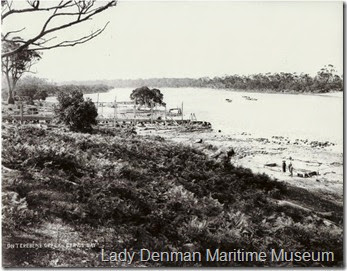 The George Thornton’s Builder.
The George Thornton’s Builder.
Thomas Macaulay 1879.
Described as a sturdy Canadian who spent most of his time at sea as a shipwright, employed by William Perverly of Balmain.
1890 Currumbene Creek showing slipways extending into the creek.
Boat Construction, Currumbene Creek 1800’s
The Macaulay yard was set up right next to the Dent yard on the banks of Currumbene Creek at Huskisson.
In 1879 Thomas Macaulay was in charge of the yard for Mr Pabeley (Peverley) of Balmain.
A visitor to the area described the scene of Thomas Macaulay’s yard on Currambene Creek in 1879 in an article in the Shoalhaven Telegraph.
…“In it is the colossal hull of what in about three months will be a brigantine… The keel of this vessel has been laid out about two years and considering the choice of material and the tact exhibited in the fittings and general work of construction. Mr Macaulay may be congratulated on the progress he has made….
For more information you can purchase from the Museum Shop a beautifully written book by Volunteer, Bridget Sant, called “Huskisson’s Ships and their builders 1861-1977.
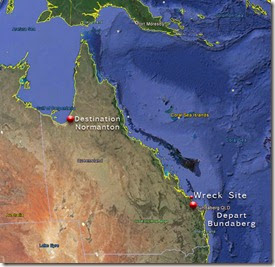 | 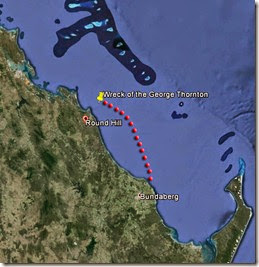 |
28 July 2014
Woollamia Church 1934
26 July 2014
The Atlantic enters Jervis Bay.
On this day 25th July 1797 Lieutenant Richard Bowen the man responsible for naming Jervis Bay died during the battle of Santa Cruz de Tenerife. |
|
|
That’s another story for a future post. |
Richard Bowen a short but distinguished life. |
|
| REF: |
25 July 2014
SS Patonga at Huskisson Wharf
| Another fantastic image from the Lady Denman’s collection. SS Patonga loading timber at Huskisson Wharf. |
24 July 2014
Time for a face lift.
The museum will be undergoing a few changes soon, the current Library will be stripped out and a complete new lining and environmental controls added.
This will then become the conservators room, where restoration and cleaning of the amazing Halloran Collection will be undertaken.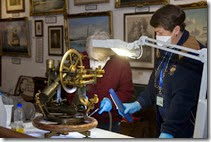
| Our web designer, blog designer, and research dept will be shipped out and find a new home in another office. Apologies to our volunteers for any inconvenience during this change. |
22 July 2014
One venturous voyage more.
 Researching the history of seafaring around the Shoalhaven region and the vessels built at Huskisson in the 18th and early 19th century your left with a feeling of amazement at the courage of the sailors and crews from that era.
Researching the history of seafaring around the Shoalhaven region and the vessels built at Huskisson in the 18th and early 19th century your left with a feeling of amazement at the courage of the sailors and crews from that era.
Many of the vessels met disaster, crews and passengers were lost, dramatic rescues and self sacrifice, the loss of any vessel was a blow to the fragile economies and families of many coastal ports and towns.
But the ones that stir the emotions the most are the ships, small and large that leave port and are never heard of again, to vanish into the briny sea, the families waiting and hoping and forever wondering, history lost and stories untold.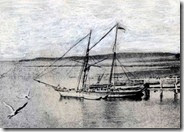 Margaret and Jane topmast schooner - 1876
Margaret and Jane topmast schooner - 1876
One such vessel built at Huskisson by William Wood was the Margaret and Jane Topmast Schooner, 51 tons, built 1868, She left the Daintree River, Queensland mid June 1876 and was not seen again.
What is her story?
The picture is the Topmast Schooner the Dairymaid, built by William Wood at Huskisson in 1867.
21 July 2014
Parts of the whole.
17 July 2014
Recycled interpretation of the Samuel Elyard.
16 July 2014
Samuel Elyard painting of Cape St George Lighthouse.
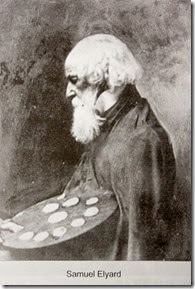 Samuel Elyard made a few trips out to the lighthouse in the 1840’s.
Samuel Elyard made a few trips out to the lighthouse in the 1840’s.
His described his trips in journals. The trip could sometimes take two days using horse drawn carriage and walking, the track wasn’t clearly marked so getting lost was a common event.
In one of his journal entries he mentions getting lost twice, getting bogged in a swamp, and spending a miserable night in a tent with native dogs howling all around, and having to leave provisions behind to lessen the load.
One you reached the lighthouse there was no accommodation for visitors, you would have to spend your nights on rough ground in tents, he describes having to refasten the tent to prevent it blowing away during the night because there was no shelter from the elements on the exposed and isolated headland.
Later on, a decent house was built for the head keeper and his family and they would sometimes let people stay in a front room.
Samuel loved the region and promoted the area to artists far and wide.
This painting from the 1840’s depicts the lighthouse as it once stood from a southern aspect.
I recently took this image from a similar position. Of course the once grand tower is gone and the cleared headland has reverted back to bush but nothing else has changed that much in 174 years.
His depiction could almost have been traced from my photograph it’s so accurate.
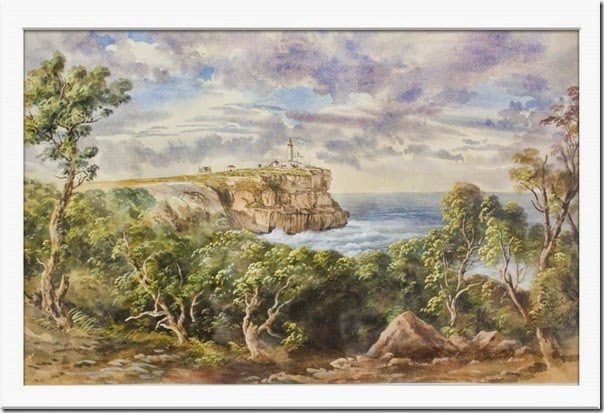 |
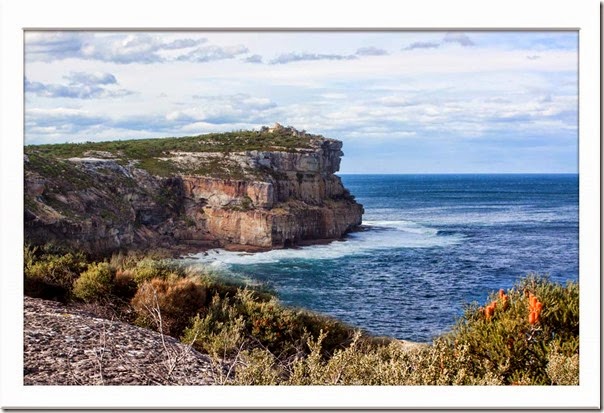 |
15 July 2014
Samuel Elyard painting of Falls Creek.
Currently on exhibition in the Vera Hatton gallery is a collection of paintings done by Samuel Elyard around 1840
Many painting depict familiar scenes in the Shoalhaven one in particular, an oil painting captures Falls Creek waterfall. Today I paid a visit and took a photograph of the waterfall at falls creek.
Here we see the original image as painted by Samuel Elyard and today’s photo.
 |
 |
14 July 2014
Super Moon
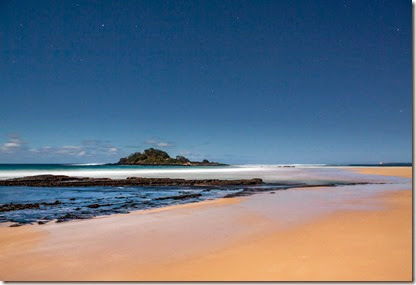 Saturday night the moon seemed exceptionally bright over the bay.
Saturday night the moon seemed exceptionally bright over the bay.
Early around 8pm there was a light wispy cloud, backed by light westerly winds slowly drifting out to sea, by 9pm the cloud had cleared and the moon bought the landscape to life. You could clearly see right across the bay clearer than usual.
Green Island at Bendalong.
I took a couple of photos of the bay and also went down to Bendalong to shoot a some scenes there.
here are a couple of shots from that little adventure.
Why was it called a Super Moon?. Technically known as a perigee moon, the marvel occurs when a full moon or new moon coincides with the closest approach the moon makes to the Earth on its elliptical orbit.
The result is that the world’s closet neighbour appears larger and brighter than usual – with breath-taking results.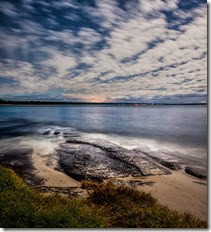

If you missed it don’t despair two other supermoons will appear later this summer on the 10 August and 9 September.
The August date is the most exciting for astronomical buffs, as the moon will be 863 miles closer than it was over the weekend, appearing at its brightest for 2014.
10 July 2014
What we do for fun

New exhibition opens Sunday the 13th July
A very interesting exhibition with some amazing pieces of artwork by local crafts people.
The exhibitions focus is on interpreting well known works of art of Samuel Elyard and Lloyd Rees
by using recycled products.
This exhibition involves Sculpture, Art installations, Embroidery, Quilting ,Tapestry.
Come along and see original artworks painted by Samuel Elyard featuring the south coast, and see the modern craftsperson's interpretation using recycled material.
A few examples from the exhibition.
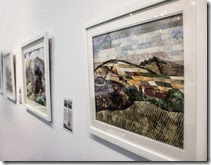 | 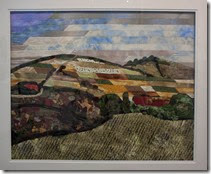 | 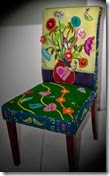 |
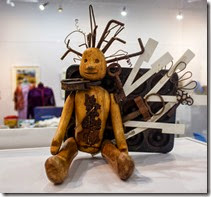 | 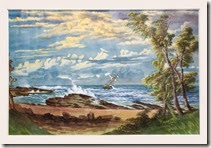 |
Ben-Louttit's-passenger-coach - Huskisson
This amazing image suggests a much more relaxed and slow moving life for the people of Huskisson in the 1800’s
7 July 2014
HMS Jervis Bay – Heroic sacrifice
HMS Jervis bay was launched in 1922.
During the years which immediately followed WWI the Australian Commonwealth Line announced that five identical twin-screw passenger-cargo liners had been ordered from British shipyards for the Australian emigrant service. The ships were specifically designed to operate a schedule of monthly departures between the ports of London, Fremantle, Adelaide, Melbourne, Sydney and Brisbane.
The new steamers, all completed during 1921 and 1922, were each named after a bay situated in each of the five federal States served by the company.
REF:http://hmsjervisbay.com/Story.BayShips.php.
She was taken over by the Royal Navy in August 1939, on the outbreak of the Second World War and hastily armed with seven 1898-vintage 6 in (150 mm) guns and two 3 in (76 mm) guns, initially assigned to the South Atlantic station as an armed merchant ship before becoming a convoy escort in May 1940.

HMS Jervis Bay at Dakar 1940.
5 November 1940.

Admiral Scheer in port at Gibraltar, circa 1936.
While on duty as sole escort of 37 merchant ships travelling between Canada and Britain she encountered the German Warship Admiral Scheer.
Knowing his ship was vastly outgunned by the German cruiser the captain of the Jervis Bay Edward Fegan ordered the convoy to scatter set a course straight at the German warship to draw it’s fire. Completely outgunned and out ranged, Captain Fegan and his crew fought on until the ship was well ablaze and sunk into the Atlantic. Captain Fegan was killed when the bridge received a direct hit and went down with his ship along with 187 of his crew, later a neutral Swedish ship amongst the convoy turned around and rescued 65 survivors.
Through Captain Fegans actions many of the ships in the convoy managed to escape saving hundreds of lives.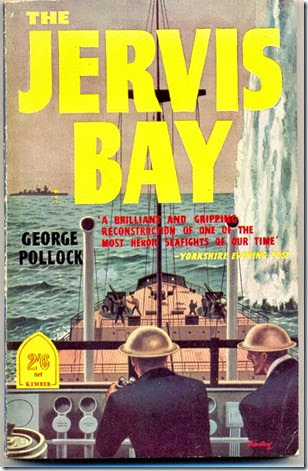
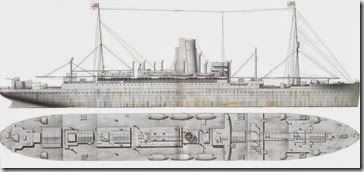 |
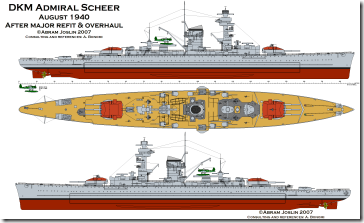 |
Unequal contest - You can clearly see the the difference between the two ships.
Another connection to Jervis Bay.
Captain Fegan.
Captain Fegan commanding officer of the armed merchant cruiser Jervis Bay served in Australia during 1928-29 as commander of the Naval College at Jervis Bay. Captain Fegen is remembered by the cadets of his time and fellow officers of his at the naval college as "Fogarty" Fegen. He was a big, strong Irishman with bushy eye
brows. Captain Fegen was always keen on athletics and physical fitness.
By Lieutenant Moss.
"It was 10 minutes before 5 o'clock when the Nazis' were sighted on the port bow. We knew what would happen, When Captain Fegan joined Jervis Bay he
told us that if ever we ran into a more powerful adversary he would try and get within range, and do what damage he could. The Jervis
Bay steamed straight for the enemy. He answered our challenge by opening fire from the forward turrets. Both salvos fell short. We
let him have abroardside from out 6-inch guns, and his second salvo flew overhead. All this time the Jervis Bay was throwing out a thick smoke screen.
and the convoy was scattering to all point on the compass. The Nazis third slavo caught us. It hit the bridge and the engine room, and amidships.
The engine stopped, and the vessel ploughed slowly to a standstill, presenting a target like a floating hotel. The shell that hit eh bridge set it afire.
Captain Fegan with his left arm mangled, went aft with the survivors to take command of the emergency steering control. I could hear the screams of the
wounded in the wreckage of the smashed bridge. Between 5 and 5.30 o'clock the Nazis' 'strafed' us heavily. By 5.15 o'clock all our forward guns except one received a
direct hit, and the crews had been blown overboard. I saw Captain Fegan making his way to the forebridge. He was never seen again.
The bridge and amidships were smashed by a heavy shell. At 5.45 o'clock came the order to abandon ship. We were in a bad way. The Jervis Bay was sinking slowly by her stern and was blazing amidships. Only one lifeboat remained. We launched that and every available raft. The Nazis' never let up.
During those last few minutes, they gave us hell with time'fuse shrapnel. With the action over, dozens of men had lost their lives. As we
pulled away flaming debris and pieces of the ship came crashing down on the boat. We could see the raider seeking our convoy with searchlights, and firing salvo after salvo. Then just after midnight, we saw a black-out hull of a ship close by. We signalled in Morse with an electric torch. It was the Swedish freighter Sturholm, one of the ships in the convoy.
Captain Orlander had told his crew that he would not leave before making sure that there were survivors of the Jervis Bay waiting to be picked up. Of the 38 ships in the convoy, all but four got home. Captain
Fegan and many other gallant men lost their lives, but they were not lost in vain."
Victoria Cross
Captain Fegen was awarded a posthumous Victoria Cross as a result of this action. The citation for the Victoria Cross reads "Valour in challenging hopeless odds and giving his life to save the many ships it was his duty to protect.
Captain Fegan received the VC, but his crew followed and fought on despite insurmountable opposition and deserved to be recognized for their courage and sacrifice and received the respect from the nation.
The full and amazing story and pictures of this heroic battle, follow the links below
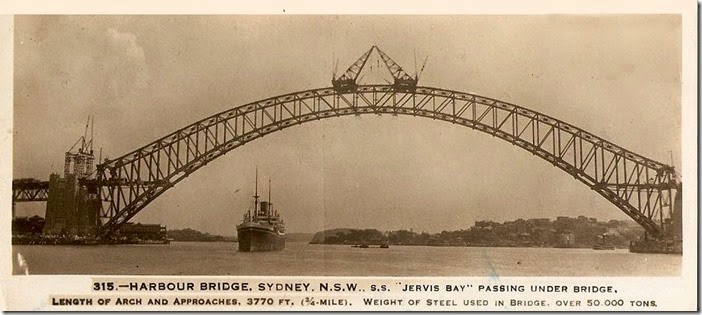
| An amazing image of the TSS Jervis Bay passing under the Harbour Bridge. |
REF:
http://museumvictoria.com.au/collections/themes/3665/ship-history-tss-jervis-bay-1922-1940?start=11
http://news.bbc.co.uk/today/hi/today/newsid_8842000/8842130.stm
http://www.hmsjervisbay.com/Story.AMC.php
http://www.internet-promotions.co.uk/archives/caithness/jervisbay.htm
https://collections.museumvictoria.com.au/articles/3665
On this day – Berry’s Canal
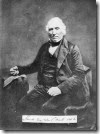 July 7th 1822 completion of Berry’s Canal
July 7th 1822 completion of Berry’s Canal
Berrys Canal was Australia’s first transport canal. In June 1822, Alexander Berry sailed his 15-tonne cutter Blanche from Sydney 150 km down the south coast to the Shoalhaven loaded with tools and provisions. Hamilton Hume, who later became a well-known explorer, was also on board. On 21 June 1822, the entrance to Shoalhaven Heads appeared dangerous and four men volunteered to test it in the cutter’s boat. The boat capsized drowning two of the men. Berry then sailed up the Crookhaven River but was stopped by a sand spit. Undaunted, the crew hauled the Blanche across the spit. Four days later Hamilton Hume was left with three men at the isthmus to cut a passage using only hand tools. The canal, which was 191 m long, was completed in 12 days. This was the first transport canal to be cut in Australia. The river has since cut the passage wider and deeper to its present dimensions, making it now the real entrance to the Shoalhaven River.





 Bowen gave the bay it’s English name.
Bowen gave the bay it’s English name.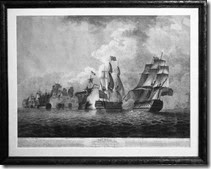
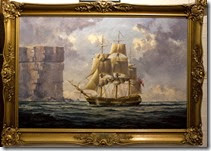 Interwar years, how it came to be?.
Interwar years, how it came to be?.